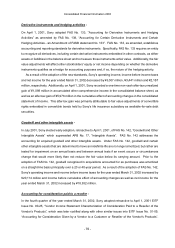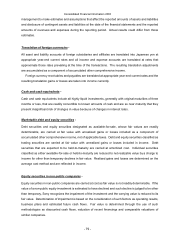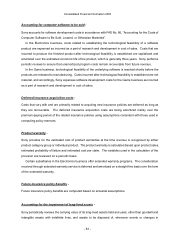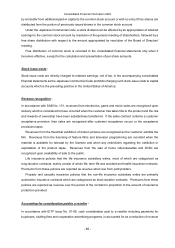Sony 2003 Annual Report Download - page 163
Download and view the complete annual report
Please find page 163 of the 2003 Sony annual report below. You can navigate through the pages in the report by either clicking on the pages listed below, or by using the keyword search tool below to find specific information within the annual report.
Consolidated Financial Information 2003
- 77 -
EITF Issue No. 01-09 clarifies the income statement classification of costs incurred by a vendor in
connection with the reseller’s purchase or promotion of the vendor’s products, resulting in certain
cooperative advertising and product placement costs previously classified as selling, general and
administrative expenses to be reflected as a reduction of revenues earned from that activity. The
accounting change did not have any effect on operating income or a material effect on net sales and selling,
general and administrative expenses for the year ended March 31, 2002. Sony has not reclassified the
financial statements for the year ended March 31, 2001 due to immateriality.
Film accounting -
In June 2000, Sony elected early adoption of Statement of Position (“SOP”) 00-2, “Accounting by
Producers or Distributors of Films”, issued by the Accounting Standards Executive Committee of the
American Institute of Certified Public Accountants. SOP 00-2 established new film accounting standards,
including changes in revenue recognition and accounting for advertising, development and overhead costs.
Specifically, SOP 00-2 requires all exploitation costs, such as advertising expenses and marketing costs,
for theatrical and television product to be expensed as incurred. This compares to Sony’s previous policy
of first capitalizing and then expensing advertising costs for theatrical and television product over the
related revenue streams. In addition, SOP 00-2 requires development costs for abandoned projects and
certain indirect overhead costs to be charged directly to expense, instead of those costs being capitalized
to film costs, which was required under the previous accounting standards. SOP 00-2 also requires all film
costs to be classified in the balance sheet as non-current assets. The provisions of SOP 00-2 in other
areas, such as revenue recognition, generally are consistent with Sony’s existing accounting policies.
Sony adopted SOP 00-2 retroactive to April 1, 2000. As a result, Sony’s net income for the year ended
March 31, 2001 included a one-time, non-cash charge with no tax effect of ¥101,653 million, primarily to
reduce the carrying value of its film inventory. The charge has been reflected as a cumulative effect of an
accounting change in the accompanying consolidated statements of income.
Revenue recognition -
In the fourth quarter of the year ended March 31, 2001, Sony adopted Staff Accounting Bulletin (“SAB”) No.
101, “Revenue Recognition in Financial Statements”, issued by the United States of America Securities and
Exchange Commission retroactive to April 1, 2000. As a result, Sony changed its method of accounting for
revenues from electronics, game and music sales. Revenues from electronics, game and music sales are
recognized upon delivery which is considered to have occurred when the customer has taken title to the
product and the risk and rewards of ownership have been substantively transferred. Following SAB No.
101, revenues are recognized when the product is delivered to the customer delivery site. Previously Sony
followed the guidance of FASB Statement of Financial Accounting Concept (“SFAC”) No. 5 “Recognition
and Measurement in Financial Statements of Business Enterprises” in which revenues were recognized
when Sony had substantially completed all of its obligations pursuant to the terms of the sales contract.
Under the guidance of SFAC No. 5, Sony viewed its obligation under the sales contract to be substantially
























